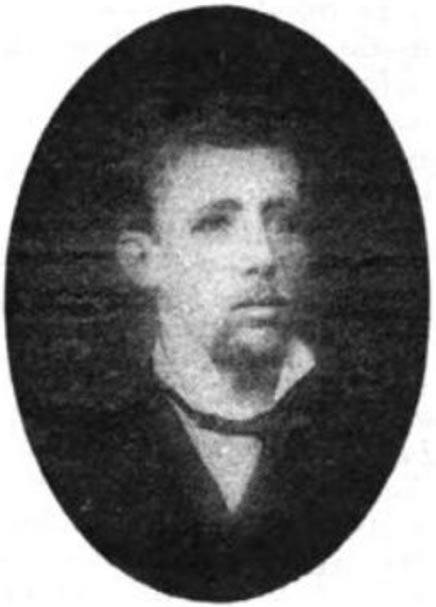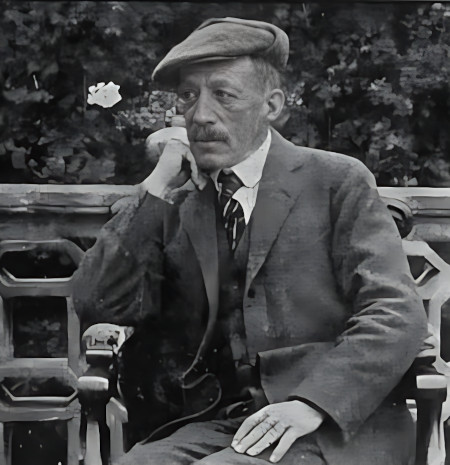Anacarsis Martínez Holguín (Ambato, July 16, 1862 – Ambato, April 1930) was an Ecuadorian writer, satirist, journalist, and politician known for his liberal activism and pioneering efforts in Ecuador’s early wine industry. Born into a prominent family, he was influenced by European intellectual traditions and pursued his education with the Jesuits in Quito. Martínez co-founded the anarchist newspaper El Combate and later launched La Avispa, a satirical publication that sharply critiqued Ecuador’s political elite. Throughout his career, he held positions as Deputy and Governor of Tungurahua, and although he was offered ministerial posts, he declined them, preferring independence. His work extended to managing the family’s Catiglata vineyard, where he applied winemaking techniques he had studied in France. Martínez’s writings, including his satirical novel El desfalco, provided pointed commentary on Ecuadorian society, solidifying his legacy as a bold voice for liberalism in early 20th-century Ecuador.
Birth and Family Background
Anacarsis Martínez Holguín was born on July 16, 1862, in Ambato, Ecuador, to Dr. Nicolás Martínez Vásconez and Adelaida Holguín Naranjo. He was one of nine siblings in a prominent Ecuadorian family known for its contributions to the country’s political, agricultural, and cultural landscape. His father, Nicolás, was a respected lawyer and pioneering viticulturist who served as both deputy and governor of Tungurahua. His mother, Adelaida, was the daughter of Ignacio Holguín, a former governor of Tungurahua, who provided the family with a well-stocked library of European literature and scientific texts, which became a formative resource for the young Martínez and his siblings.
Several of Anacarsis Martínez Holguín’s siblings were also writers and intellectuals, making notable contributions to Ecuadorian literature and culture. His brother Luis Alfredo Martínez was a distinguished novelist, painter, and politician, best known for his novel A la Costa (1904), which is a landmark in Ecuadorian literature. His sister Cornelia Martínez was also a writer and opera singer, recognized for her strong character and leadership within the family after their father’s death. Another brother, Augusto N. Martínez, was a respected volcanologist, geologist, and historian whose scientific explorations and publications, such as Crónica de los fenómenos volcánicos y terremotos en el Ecuador (1896) and Vulcanología y geología de los Andes ecuatorianos (1905), expanded the geological understanding of Ecuador’s volcanic regions. Together, the Martínez siblings were part of Ecuador’s educated elite, collectively influencing the country’s intellectual, political, and agricultural development in the late 19th and early 20th centuries.
The family maintained close ties with their cousin and notable neighbor, Juan León Mera Martínez, who lived nearby at his estate, Hacienda Atocha. Mera, the celebrated author of Cumandá and lyricist of Ecuador’s national anthem, was an influential figure in Ecuadorian literature and a prominent presence in the Martínez family’s intellectual circle.
Early Life and Education
Anacarsis grew up in a well-educated household where intellectual pursuits were highly valued. He was described as the most introverted and reserved of his siblings, a characteristic attributed to his close relationships with his mother and sister Cornelia. He pursued his education with the Jesuits in Quito, where he developed an early passion for French culture and language. His family connections and early exposure to European thought significantly influenced his later political and literary interests.
Political and Literary Career
Martínez was a committed liberal thinker and activist. Influenced by the radical liberal ideas of Ecuadorian writer and satirist Juan Montalvo, he co-founded the anarchist newspaper El Combate at age 21 with Juan Benigno Vela and Celiano Monge. In 1887, he founded La Avispa, a satirical newspaper critiquing the political climate of the time with humor and sharp commentary. The publication, which he edited, quickly gained attention for its bold criticism of Ecuador’s wavering political landscape, although it only ran for six issues. He also worked on El Pelayo, another satirical paper, alongside Vela.
Throughout the late 1880s, Martínez represented Tungurahua as a Deputy in Ecuador’s Congress, continuing his advocacy for liberal reforms. Although he was offered ministerial positions twice, he declined, preferring to work independently. In 1911, he served as the Governor of Tungurahua during a challenging period for Ecuadorian liberalism. His writings, often reflective of his political ideas, were published in prominent Ecuadorian journals, including Revista Ecuatoriana and Revista Guayaquil. His notable works include his acclaimed article “Las ilusiones de un gamonal” and the satirical novel El desfalco, which appeared in the Revista de Bellas Letras de Quito in the late 1920s.
Satirical and Political Journalism
Anacarsis Martínez Holguín was an influential figure in Ecuadorian satirical journalism, using publications to critique political figures and champion liberal ideals. His work in journalism reflects his commitment to addressing the issues of his time through humor and sharp commentary. Martínez collaborated with other prominent liberals, such as Juan Benigno Vela and Celiano Monge, to establish platforms that challenged Ecuador’s conservative establishment. Here is a list of his major journalistic endeavors:
- El Combate (1883) – Co-founded with Juan Benigno Vela and Celiano Monge, this anarchist newspaper was dedicated to promoting liberal ideals and political critique, serving as an early platform for radical liberal thought in Ecuador.
- La Avispa (1887) – A satirical publication primarily edited by Martínez, La Avispa used humor to critique the wavering political climate of the time.
- El Pelayo – Created in collaboration with Juan Benigno Vela, El Pelayo was another satirical newspaper aimed at Ecuador’s political elite, employing satire to target corruption and incompetence in public life.
Ventures in Viticulture
Anacarsis Martínez also played a key role in Ecuador’s early wine industry, continuing the legacy of his father’s viticulture enterprises at the family’s Catiglata estate. After studying viticulture in France, where he was sponsored by French businessman Luciano Laffite, Martínez returned to Ecuador in 1887 with winemaking equipment and books on agricultural practices. He managed approximately five hectares of vineyards, producing red, rosé, and white wines, and sought to train younger family members in winemaking around 1915. However, his efforts to pass on these skills were largely unsuccessful, and the Catiglata winery eventually ceased operations near the time of his death in 1930.
Travel and Later Life
In 1889, Martínez undertook a second trip to France, expanding his studies in winemaking and exploring ceramics manufacturing. In 1914, while seeking medical treatment in Europe, World War I broke out, and his financial situation became unstable. Although the Ecuadorian government offered him a consular post as a form of assistance, he declined, considering it a charitable gesture rather than a formal appointment. After his return to Ecuador, he temporarily taught at the Quinta Normal Agricultural School around 1920.
Personal Life
Martínez married Elina Saá, but they did not have children. He remained a private, introspective figure, often described as deeply devoted to his mother and sister Cornelia. Martínez continued to live on the Catiglata estate with his wife until his later years.
Death and Legacy
Anacarsis Martínez Holguín passed away in April 1930 at the age of 68. His life is remembered as a blend of literary and political contributions with pioneering efforts in viticulture. His work in journalism, characterized by its satirical edge and liberal ideals, left a notable mark on Ecuadorian political commentary. Although his winery enterprise did not endure beyond his lifetime, his contributions to Ecuador’s early wine production remain part of his legacy, as do his writings, which provided an incisive critique of Ecuador’s political and social structures.
Timeline of Anacarsis Martínez Holguín’s Life
- 1862: Born on July 16 in Ambato, Ecuador, to Dr. Nicolás Martínez Vásconez and Adelaida Holguín Naranjo. He was raised in a prominent family with strong intellectual, political, and agricultural traditions.
- 1883 (Age 21): Founded the anarchist newspaper El Combate with Juan Benigno Vela and Celiano Monge, marking his entry into political activism and journalism with a focus on liberal ideals.
- 1886 (Age 24): Made his first trip to France, sponsored by French businessman Luciano Laffite, where he stayed with the Laffite family in Paris. During this trip, he studied viticulture and winemaking, made contact with the influential Ecuadorian writer Juan Montalvo, and was introduced to modern French agricultural practices.
- 1887 (Age 25): Returned to Ecuador with French winemaking equipment, including a Mabille wine press, a vine fumigation machine, French grape varieties, and viticultural texts. This same year, his father Nicolás passed away, and Anacarsis took over the management of the family’s Catiglata estate.
- 1887 (Age 25): Founded the satirical newspaper La Avispa, in which he sharply critiqued Ecuador’s political landscape. This newspaper quickly gained attention for its bold commentary, though it ran for only six issues.
- 1889 (Age 27): Made a second trip to France to further study viticulture and ceramics manufacturing, gaining additional expertise that he brought back to Ecuador.
- Late 1880s: Served as a Deputy for the Tungurahua Province, representing the interests of his region and continuing his advocacy for liberal reforms.
- 1911 (Age 49): Appointed Governor of Tungurahua, where he navigated a challenging period for Ecuadorian liberalism.
- 1914: While in Europe seeking medical treatment, World War I broke out, stranding him in difficult financial circumstances. The Ecuadorian government offered him a consular position as a form of aid, but he declined, viewing it as a charitable gesture rather than a proper appointment.
- 1915 (Age 53): Made a third trip to France. Upon returning to Ecuador, he attempted to train three nephews—Ernesto Jurado, Edmundo Martínez Mera, and Paco Ruales Martínez—in winemaking at Catiglata, though the effort proved unsuccessful.
- 1920 (Age 58): Briefly served as a temporary teacher at the Quinta Normal Agricultural School, where he shared his agricultural knowledge.
- 1921 (Age 59): His mother, Adelaida, passed away. He inherited shared ownership of the Catiglata estate with his brother Augusto.
- 1927 (Age 65): Family relationships began to deteriorate, leading his brother Augusto to leave Catiglata for Quito. Around this time, Anacarsis started focusing more on his literary pursuits, publishing the satirical novel El desfalco in the Revista de Bellas Letras de Quito. Meanwhile, wine production at the Catiglata estate began to decline.
- Throughout His Adult Life: Anacarsis lived at the Catiglata estate with his wife, Elina Saá, though they did not have children. He managed the family’s approximately 5-hectare vineyard, producing red, rosé, and white wines and operating the Catiglata wine factory. Alongside his work in viticulture, he directed the liberal newspapers La Avispa and El Pelayo, where he championed progressive political ideas through satire. He also operated a sulfur mine in Píllaro, expanding his interests beyond agriculture and journalism.
- April 1930 (Age 68): Passed away at the Catiglata estate, marking the end of a life dedicated to literature, political activism, and pioneering contributions to Ecuadorian winemaking.
Pictures

Works
Fiction
- El desfalco – A satirical short novel published in the Revista de Bellas Letras de Quito in the late 1920s, which humorously critiques corruption and social issues in Ecuador.
Essay
- “Las ilusiones de un gamonal” – Published in Revista Guayaquil, this article is one of Martínez’s best-known pieces, exploring the illusions and realities faced by the Ecuadorian rural elite (gamonales) in a liberalizing society.
References
- Rodolfo Pérez Pimentel. Martínez Anacarsis. Retrieved on November 11, 2024. Click to view
- FLACSO Andes Repository. La modernización del viñedo y de la vinificación en el Ecuador (1866-1930) by Francisco Eduardo Urrutia Jiménez. Retrieved on November 11, 2024. Click to view

